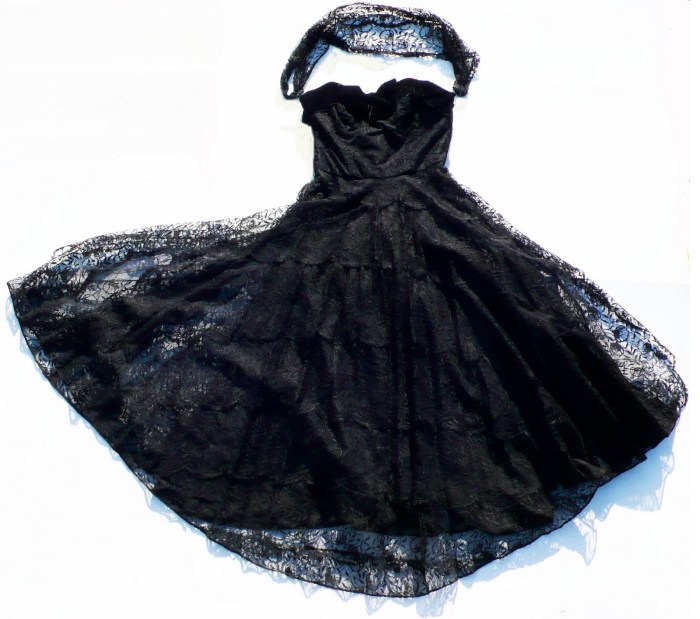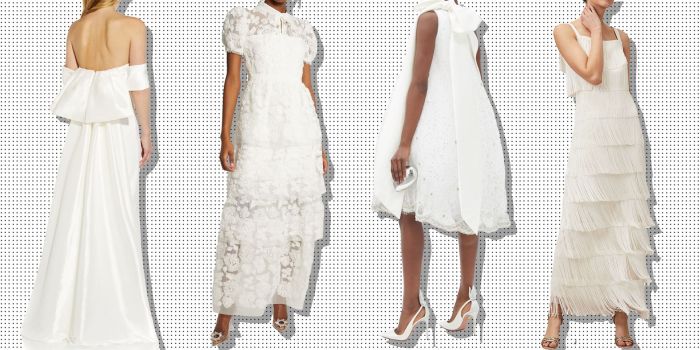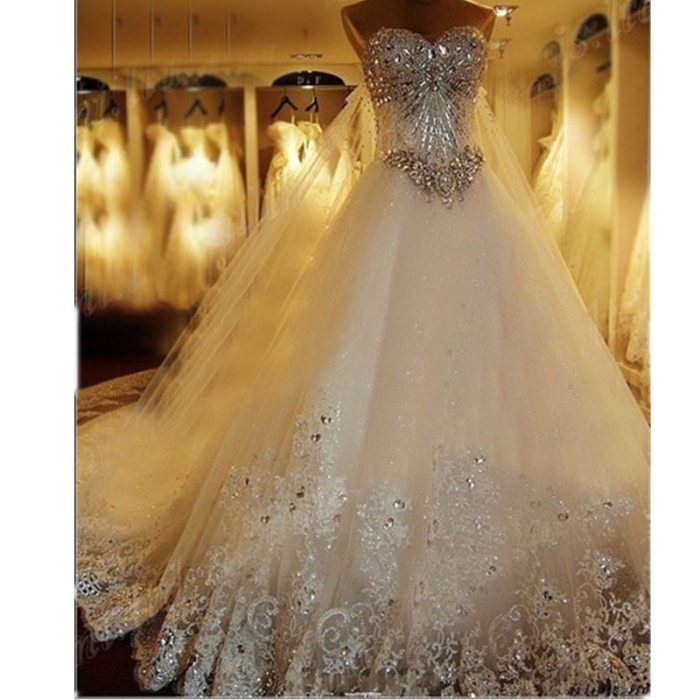Evolution of Antique Wedding Dress Styles (1880-1950s)
Antique wedding dress styles – The evolution of wedding dress styles from 1880 to the 1950s reflects significant societal shifts, technological advancements, and evolving aesthetic preferences. From the voluminous silhouettes of the Victorian era to the streamlined elegance of the 1930s, each decade brought distinct characteristics to bridal fashion.
Wedding Dress Styles: 1880-1900
The late Victorian era (1880-1900) saw wedding gowns dominated by full, voluminous silhouettes. Heavy fabrics like satin, silk, and brocade were commonly used, often layered to create a dramatic effect. High necklines, long sleeves, and elaborate trains were characteristic features. These designs reflected the prevailing social norms of modesty and formality.
Comparing Victorian and Edwardian Styles
The Edwardian era (1901-1910) ushered in a slightly more streamlined silhouette compared to the Victorian era. While still relatively full, the gowns became less bulky, with a greater emphasis on delicate fabrics like lace and chiffon. Necklines remained high, but the overall look was less restrictive, reflecting a shift towards a more relaxed social atmosphere. The S-bend silhouette, achieved with corsetry, was a defining feature of this period.
Impact of World War I on Wedding Dress Fashion
World War I (1914-1918) significantly impacted wedding dress fashion. The war effort led to fabric rationing and a simplification of styles. Gowns became more practical and less ornate, often featuring simpler silhouettes and less elaborate embellishments. The use of darker colors, such as navy blue or gray, became more prevalent as a reflection of the somber times.
1920s Flapper Influence
The roaring twenties brought a dramatic shift towards shorter hemlines and looser silhouettes. The influence of the flapper style is evident in the dropped waistlines, beaded embellishments, and shorter lengths of wedding gowns. These dresses reflected the era’s embrace of modernity and a more liberated female image.
1930s and 1940s Styles and World War II’s Impact
The 1930s saw a return to more classic and elegant styles, with bias-cut gowns and long, flowing silhouettes becoming popular. World War II (1939-1945) once again impacted fashion, leading to further simplification of styles. Fabric rationing resulted in more modest gowns, often made from simpler fabrics and with minimal embellishments. However, even with limitations, designers still managed to create elegant and stylish dresses.
Comparison of Wedding Dress Styles (1880-1950s)

Source: googleusercontent.com
| Decade | Neckline | Sleeves | Silhouette | Fabrics |
|---|---|---|---|---|
| 1880s-1890s | High, often closed | Long, often puffed or gathered | Full, voluminous | Satin, silk, brocade |
| 1900s-1910s | High, sometimes slightly lower | Long or elbow-length | Full, S-bend silhouette | Lace, chiffon, silk |
| 1920s | Low, V-neck or dropped | Short or sleeveless | Dropped waist, loose | Beaded fabrics, silk, satin |
| 1930s | V-neck, round neck | Long or short | Bias-cut, long and flowing | Silk, satin, crepe |
| 1940s | High or V-neck | Long or short | Simple, A-line or fitted | Wartime fabrics, simpler materials |
Lace and Embellishments in Antique Wedding Dresses: Antique Wedding Dress Styles
Lace and embellishments played a crucial role in antique wedding dresses, not only enhancing their aesthetic appeal but also conveying social status and personal style. The intricate details often reflected the craftsmanship and resources available to the bride.
Types of Lace and Their Significance

Source: hearstapps.com
Various types of lace, each with its own unique characteristics, were used in antique wedding gowns. Alençon lace, known for its delicate floral patterns, was a luxurious choice, while Chantilly lace, with its intricate geometric designs, offered a different aesthetic. Irish lace, with its characteristic openwork, provided a lighter and airier feel. The type of lace often indicated the bride’s social standing and the overall cost of the dress.
Beading, Embroidery, and Other Embellishments
Beading, embroidery, pearls, and other embellishments were integral elements in antique wedding dresses. The richness and intricacy of these details often signaled the bride’s social status and the family’s wealth. Intricate beadwork, for instance, could take months to complete, reflecting significant investment and craftsmanship.
Creating Different Effects with Embellishments
Different embellishments were used to create various effects. Beading could add shimmer and sparkle, while embroidery could create textured patterns. The strategic placement of embellishments could also emphasize certain aspects of the gown’s design, such as the neckline or waistline.
Techniques for Applying Embellishments, Antique wedding dress styles
- Hand-sewing: The most common method, requiring skilled artisans.
- Beading: Individual beads were meticulously sewn onto the fabric.
- Embroidery: Intricate designs were stitched onto the fabric using various techniques.
- Appliqué: Lace or other fabrics were sewn onto the gown.
Regional Variations in Antique Wedding Dress Styles
Wedding dress styles in the late 19th and early 20th centuries varied considerably across different regions of Europe, reflecting distinct cultural traditions and local craftsmanship. These regional variations offer fascinating insights into the diverse aesthetic preferences and social customs of the time.
Antique wedding dress styles often feature intricate lace and delicate beading, reflecting the craftsmanship of bygone eras. For a modern take on these classic designs, consider the elegant silhouettes offered by amanda novias wedding dress , a brand known for its sophisticated bridal gowns. Their collections often draw inspiration from historical styles, offering a contemporary interpretation of antique wedding dress aesthetics.
Regional Differences in Wedding Dress Styles
French wedding gowns often incorporated luxurious fabrics and intricate lacework, reflecting the country’s reputation for high fashion. English styles sometimes featured more restrained elegance, with a focus on quality fabrics and classic silhouettes. German styles might incorporate regional embroidery or distinctive textile patterns, showcasing local traditions. These variations highlight the rich tapestry of European bridal fashion.
Influence of Regional Traditions
Regional traditions significantly influenced the design and materials used in wedding dresses. For example, the use of specific types of lace or embroidery could be tied to local craft traditions, while the choice of colors might reflect regional customs or superstitions. The integration of local fabrics and embellishments gave each region a unique bridal aesthetic.
Impact of Cultural and Religious Practices
Cultural and religious practices also played a crucial role in shaping wedding dress styles. Religious customs often dictated the level of modesty required, influencing neckline and sleeve styles. Cultural traditions might dictate the use of specific colors or symbols in the gown’s design. These influences resulted in a diverse range of styles across Europe.
Regional Differences in Antique Wedding Dress Styles
| Region | Typical Silhouettes | Common Fabrics | Characteristic Embellishments |
|---|---|---|---|
| France | Fitted bodice, full skirt | Silk, satin, lace | Intricate lace, beading |
| England | A-line, empire waist | Silk, wool, lace | Simple embroidery, delicate lace |
| Germany | Fitted bodice, full skirt | Linen, wool, brocade | Regional embroidery, ribbons |
Preservation and Restoration of Antique Wedding Dresses
Preserving antique wedding dresses presents unique challenges due to the age and fragility of the fabrics and embellishments. Proper handling, cleaning, and storage are crucial to maintain the condition of these delicate garments.
Challenges in Preserving Antique Wedding Dresses
Fabric degradation is a major concern, with age causing weakening, discoloration, and potential damage to the fibers. Embellishments, such as beading and embroidery, can also become loose or damaged over time. Environmental factors, like light and humidity, can further accelerate deterioration.
Methods for Cleaning and Restoring Antique Wedding Dresses
Cleaning and restoration should be undertaken by experienced professionals specializing in textile conservation. Gentle cleaning methods are employed to remove dirt and grime without damaging the fabric. Damaged areas may require careful repair using appropriate materials and techniques. The process requires expertise and patience to ensure the preservation of the garment.
Proper Storage and Handling Techniques
Proper storage and handling are essential for long-term preservation. Gowns should be stored in acid-free boxes in a cool, dark, and dry environment. They should be handled with clean, cotton gloves to prevent transfer of oils and dirt. Regular inspection can help identify any potential problems early on.
Basic Cleaning Procedure for an Antique Wedding Dress
A basic cleaning procedure might involve gentle brushing to remove loose dirt and debris. Any stains should be carefully assessed and treated by a professional conservator. The dress should then be carefully stored in an appropriate environment to prevent further deterioration. It is crucial to avoid harsh chemicals or aggressive cleaning methods that could irreparably damage the fabric.
Iconic Antique Wedding Dresses and Their Influence
Several iconic antique wedding dresses have left an indelible mark on bridal fashion, influencing styles for generations to come. These dresses are not only aesthetically stunning but also hold significant historical and cultural value.
Descriptions of Iconic Antique Wedding Dresses
Grace Kelly’s wedding dress, a classic example of 1950s elegance, featured a high neckline, long sleeves, and a fitted bodice with a full skirt. The simple yet refined design has remained timeless and continues to inspire modern brides. Another iconic dress, perhaps from the 1920s, might be characterized by its dropped waist, beaded embellishments, and shorter length, reflecting the flapper era’s influence on bridal fashion.
A third example, possibly from the late Victorian era, might be remembered for its full, voluminous silhouette, heavy fabrics, and intricate lace detailing, reflecting the opulence of the period.
Lasting Impact on Modern Wedding Fashion
These iconic dresses have had a lasting impact on modern wedding fashion, influencing trends in silhouettes, fabrics, and embellishments. The enduring appeal of classic designs, such as Grace Kelly’s gown, showcases the timeless elegance of antique wedding dress styles and their continued relevance in contemporary bridal fashion.
Descriptions of Three Iconic Antique Wedding Dresses
Dress 1 (Victorian Era): A breathtaking gown of ivory silk satin, featuring a fitted bodice with a high neckline and long, flowing sleeves. The skirt is incredibly full, achieved through layers of fabric and crinolines. Intricate Alençon lace adorns the bodice and sleeves, adding a touch of delicate elegance. The dress represents the opulence and formality of Victorian-era weddings.
Dress 2 (1920s): This flapper-inspired gown is made of shimmering silver beaded fabric, showcasing a dropped waist and a short, A-line skirt. The neckline is low and V-shaped, revealing a hint of skin. The dress’s overall design exudes modernity and reflects the liberated spirit of the 1920s.
Dress 3 (1950s): Grace Kelly’s wedding dress, a symbol of classic Hollywood elegance, is crafted from ivory silk faille. It features a high neckline, long sleeves, and a fitted bodice that gracefully flows into a full skirt. The simplicity of the design is enhanced by the delicate floral lace accents at the neckline and sleeves. The dress epitomizes timeless elegance and sophistication.
FAQ Summary
How can I determine the age of an antique wedding dress?
Careful examination of the construction techniques, fabric type, and embellishments, along with any accompanying documentation, can help determine the approximate age. Consulting with a textile expert or antique appraiser is recommended for accurate dating.
What are the common signs of damage in antique wedding dresses?
Common damage includes fabric discoloration, tears, moth holes, broken or missing embellishments, and general weakening of the fabric structure due to age and previous handling.
Where can I find antique wedding dresses for sale?
Antique shops, online auction sites, and specialized vintage clothing retailers often carry antique wedding dresses. However, careful vetting of sellers and authenticity checks are crucial.
Are antique wedding dresses comfortable to wear?
Comfort varies greatly depending on the style and construction of the dress. Some antique dresses may be less comfortable than modern gowns due to the fabrics and silhouettes used. Alterations may be necessary to ensure a comfortable fit.


:max_bytes(150000):strip_icc()/RocklandGown1-6b95302b00054d018c60e17663071c9a.jpg?w=700)
